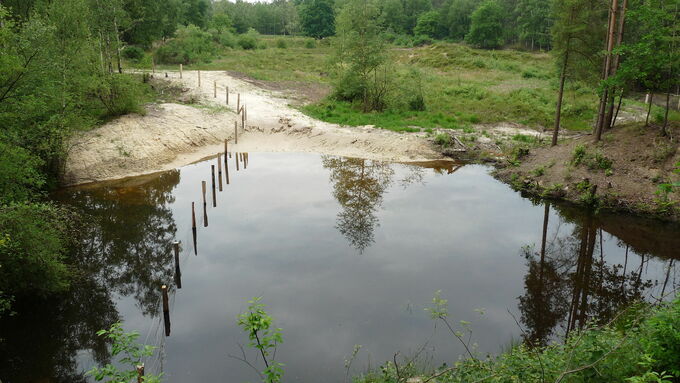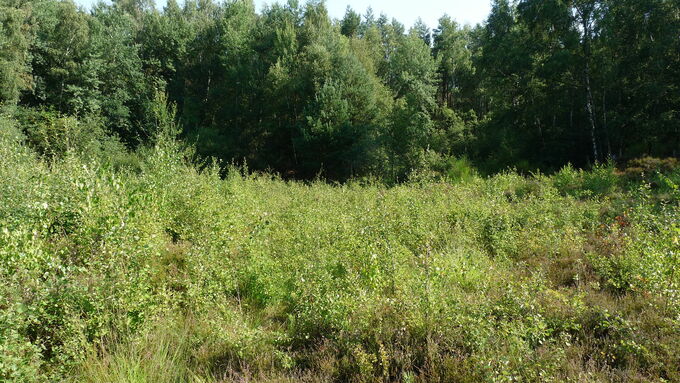After the installation of a fence, the waterbody is now well protected. © Niels Ribbrock, Biological Station of the district Recklinghausen
main content
Project of the month
#1/2022 NSG RÜTTERBERG-NORD (DORSTEN)
Optimization of a heath pond and dry heaths
The nature reserve ‘Rütterberg-Nord’ (NSG RE-010) is part of the SAC ‘Postwegmoore u. Rütterberg-Nord’ (DE-4307-3019) which is located on the city borders of Dorsten and Bottrop. It is a former sand and gravel excavation that was operated over a long period of time. Since materials were excavated at different depths, the area today has a strong surface relief which in addition changes on a small scale. A variety of habitat types was able to develop here. In the southern part of the nature reserve, these are predominantly heather stands, with small areas of wet heaths and small sandy dry grasslands interspersed. The owner of the area is the local group of the ‘Nature and Biodiversity Conservation Union’ (NABU Dorsten) which, under the leadership of Aloys Fockenberg, has secured the heath through decades of voluntary work, purchase of land and grazing projects under contract, and has been able to preserve large areas in a favourable conservation status. However, in other areas which could hardly be maintained or where long-term optimization would only have been possible with considerable use of machinery, the wet and dry heaths became overgrown and senescent and waterbodies eutrophicated.
Thus, a formerly nutrient-poor heath pond in the area had also become eutrophicated and increasingly shaded due to progressive succession. The surrounding dry heath was in an incipient stage of senescence and scrub encroachment. The habitats of the sand lizard (Lacerta agilis) and the crested newt (Triturus cristatus) were also affected negatively; the yellow-spotted whiteface (Leucorrhinia pectoralis) was even considered to have completely disappeared from the degenerated heath pond. Since there had been recent reports of findings from the Bottrop areas of the SAC, it seemed necessary to reactivate former habitats by optimizing them. Therefore, from November 2020 to January 2021, works on habitat optimization were carried out within the framework of the LIFE IP Atlantic Region DE in cooperation with the Biological Station of the district of Recklinghausen, the lower nature conservation authority of the district of Recklinghausen and NABU Dorsten.
In order to achieve a medium-term enlargement and optimization of the dry heath (habitat type 4010) and an interlocking with the adjacent heath pond, and thus to improve the habitat quality for the above-mentioned species, the area was worked on in several steps. First, in fall 2020, woods along the edge of the heath and on the adjacent slopes were removed. Then, in January 2021, the topsoil of the heath was stripped off on a small scale in the transition to the heath pond, and the waterbody was (partially) desludged. To prevent the many wild boars in the area from using the waterbody as a wallow, it was fenced off. Now there is a possibility that the heath pond will develop towards the habitat type ‘dystrophic lakes and ponds' (habitat type 3160).
The works within the framework of the LIFE Integrated Project thus optimized a larger area for habitat type 4030 and developed smaller areas of habitat types 4010 and 3160. With the optimization of the heath pond, habitat for the three focal species was restored. The co-operation partners will jointly implement necessary management measures in the coming years.
Related topics
- Habitat type 4030 – Northern Atlantic wet heaths with Erica tetralix
- Habitat type 3160 – Natural dystrophic lakes and ponds
- Species profile Yellow-spotted whiteface (Leucorrhinia pectoralis)
- Species profile Crested newt (Triturus cristatus)
- Species profile Sand lizard (Lacerta agilis)
Further Links
- Nature reserve ‘Rütterberg-Nord‘ – Landesamt für Natur und Umweltschutz (in German) (external link opens in a new window)
- SAC ‘Postwegmoore u. Rütterberg-Nord’ (DE-4307-301) – Landesamt für Natur und Umweltschutz (in German) (external link opens in a new window)
- Biological Station of the district Recklinghausen (in German) (external link opens in a new window)
- NABU Dorsten (in German) (external link opens in a new window)





